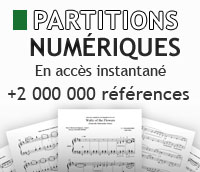| Satie, Erik - Valse "Poudre d'Or" for String Quartet Quatuor à cordes |
VoirPDF : Valse "Poudre d'Or" for String Quartet (7 pages - 141.47 Ko)305x⬇ MP3 : Valse "Poudre d'Or" for String Quartet 43x⬇ 762x
| Compositeur : | Satie, Erik (1866 - 1925) | ||||
| Instrumentation : | Quatuor à cordes | ||||
| Genre : | Romantique | ||||
| Arrangeur : Editeur : | MAGATAGAN, MICHAEL (1960 - ) | ||||
| Date : | 1901 | ||||
| Droit d'auteur : | Public Domain | ||||
| Ajoutée par magataganm, 17 Oct 2016 Immediately after the turn of the twentieth century, Erik Satie turned his compositional attention, at least partially, to waltz songs, popular in the dance halls of Paris at the time. Most of these pieces were composed for voice and piano or for solo piano. Although only a few of these waltzes have been published, Satie's sketchbooks contain dozens of waltz strains. It seems that Satie was regularly composing waltzes for different venues in the city and for certain performers. Only the most famous of these waltzes were published. A series of these, published by Baudoux and later by Bellon, Ponscarme & Cie, was known as the Danses d'Erik Satie. Included in this series is the song performed by the famous singer Paulette Darty, Je te veux (1902). Other waltzes published were Tendrement (1903) and La Diva de l'Empire (1904). The first waltz of the series was Poudre d'Or (1901), which translates as Gold Dust, issued in 1902. Poudre d'Or was published as a waltz for solo piano, with the musical material being drawn from four waltz strains composed by Satie. However, Poudre d'Or was also the title of an orchestral suite consisting of six strains, sharing only the primary strain with the piano version. The sketches of the orchestral suite are very sparse and do not convey the completed work. A number of parts for individual instruments of the suite have been recovered, but not enough to reconstruct the entire piece. Therefore, Poudre d'Or has one complete identity as a piano waltz. The structure of this piece is relatively basic, especially for Satie. This song consists of a waltz and a trio, with an introduction and a coda. As stated earlier, Poudre d'Or consists of four melodic strains. The first two strains make up the waltz proper, while the final two strains comprise the trio. The overall structure is rounded, as the waltz returns after the completion of the trio. Also, the first statement of the waltz and the trio also have a rounded form, with the first strain of each section returning after each section's second strain. The introduction lasts eight bars, while the coda consists of a restatement of the primary strain followed by five quick four bar phrases. From only four melodic strains an extensive form of almost 300 bars is created. This piece is also virtually conventional in its treatment of melody, accompaniment, and harmony. Throughout most of Poudre d'Or, the melody is presented in a single voice at the top of the texture, with the standard waltz accompaniment (oom-pah-pah) below. Satie, for the most part, leaves out his quirky chromaticism in this work. Only at the end of a few phrases does a bit of chromaticism sneak into the texture, leading to the cadence. The piece ends with a grandiose series of cadential patterns, which seem to poke fun at the exorbitant finales of "classical" works. Although originally composed for Piano, I created this interpretation for String Quartet (2 Violins, Viola & Cello). Partition centrale : | Poudre d'or (3 partitions) | | |||
© 2000 - 2024
Accueil - Nouveautés - Compositeurs
Mentions légales - Version intégrale








